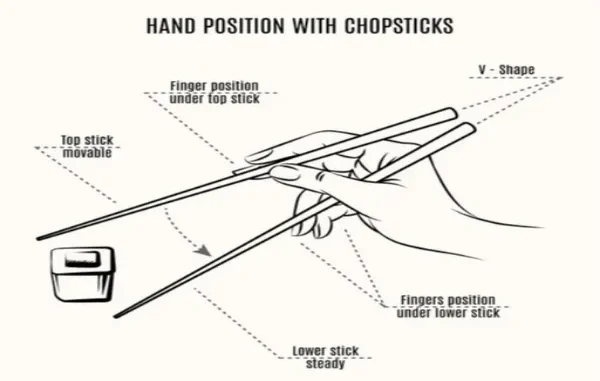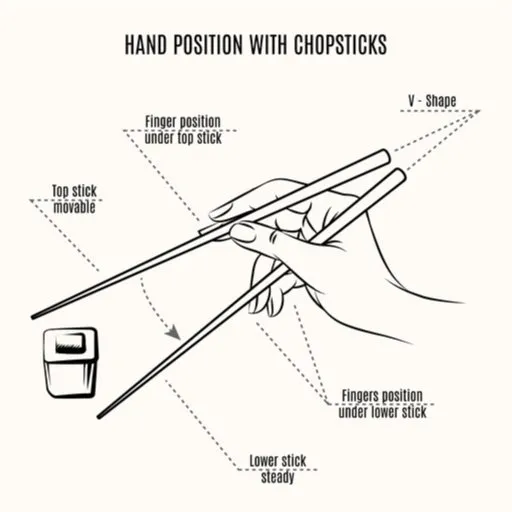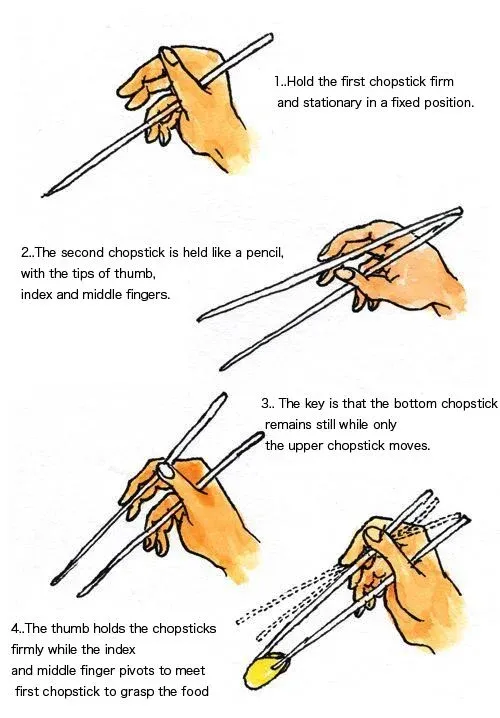
In this guide, you’ll learn everything from holding chopsticks correctly to common mistakes to avoid. Let’s get started!
Chopsticks are more than just eating utensils—they’re a part of centuries-old traditions and cultures, especially in East Asian countries like China, Japan, Korea, and Vietnam. While they may seem tricky to use at first, with a little practice and the right technique, anyone can master them.
A Brief History of Chopsticks
Before diving into how to use chopsticks, it’s worth appreciating their origins. Chopsticks date back over 3,000 years and were first used in ancient China. They later spread to other parts of Asia, evolving slightly in size and material depending on regional customs. For example:
- Chinese chopsticks are long and blunt-ended.
- Japanese chopsticks are shorter and more pointed.
- Korean chopsticks are often made of metal and slightly flat.
Understanding this background can help you respect the cultural context behind their use.
How to Hold Chopsticks: Step-by-Step for Beginners

Holding chopsticks properly is the foundation of using them effectively—and it’s easier than it looks once you break it down. Follow these simple steps to get started:
Step 1: Grab both chopsticks with one hand to get a basic grip.
Step 2: Use your other hand to line up the chopsticks evenly.
Step 3: Adjust your original grip, shifting your fingers into the correct position.
Step 4: That’s it—you’re ready to practice!
Now, let’s fine-tune your technique:
Practice 1: Hold the upper chopstick like a pencil, about one-third of the way down from the top.
Practice 2: Place the lower chopstick against your ring finger, resting it on the base of your thumb. It should point in the same direction as the upper one and stay still while eating.
Practice 3: Move only the upper chopstick using your thumb, index, and middle fingers. You’ll pick up food by pinching it between the two chopsticks.
With a little practice, you’ll be using chopsticks with ease and confidence!
Step-by-Step: How to Use Chopsticks

Step 1: Hold the First Chopstick
- Place the first chopstick in the crook of your thumb and rest it gently against the side of your ring finger.
- This chopstick stays stationary—it acts as the base.
Step 2: Grip the Second Chopstick
- Hold the second chopstick like a pencil using your thumb, index, and middle fingers.
- This is the chopstick that moves.
Step 3: Practice the Movement
- Only the top chopstick should move.
- Practice opening and closing the chopsticks by moving the top one up and down.
- Try picking up small items like beans, pieces of fruit, or rice one at a time.
Tips for Using Chopsticks Properly
- Be patient – Like learning to write with your non-dominant hand, it takes time and coordination.
- Start with larger food pieces – Sushi, dumplings, or thick noodles are easier to pick up than grains of rice.
- Keep your hand relaxed – Don’t grip too tightly; it will tire your fingers quickly.
- Use your fingertips, not your whole hand – Keep movements subtle and controlled.
Common Mistakes to Avoid
- Crossing your chopsticks – This can be seen as a sign of bad luck or disrespect in some cultures.
- Stabbing food – Chopsticks are not skewers. Try to pinch food between the sticks instead.
- Pointing with chopsticks – Considered rude in many Asian cultures.
- Sticking chopsticks upright in rice – This resembles funeral offerings in Japan and China and is considered taboo.
Cultural Etiquette to Know
If you’re dining in an East Asian country or restaurant, keep these etiquette rules in mind:
- Don’t pass food from chopstick to chopstick – This mimics a funeral ritual in Japan.
- Use a chopstick rest if available – Don’t place chopsticks directly on the table.
- Wait your turn – Don’t hover your chopsticks over shared dishes.
What to Use When You’re Struggling
If you’re having a hard time with traditional chopsticks:
- Try training chopsticks – Great for beginners or kids, these often come with finger loops.
- Use rubber bands – Wrap one around the top of the chopsticks to hold them together like tongs.
- Start with wooden or bamboo chopsticks – These offer better grip than plastic or metal versions.
Final Thoughts
Learning how to use chopsticks is both a practical skill and a great way to show respect for cultures where they’re commonly used. While it may feel awkward at first, with practice and patience, you’ll soon be picking up everything from noodles to dumplings with ease.
Whether you’re traveling through Asia or just enjoying sushi night at home, mastering chopsticks will enhance your dining experience and cultural appreciation.
Enjoy your meal — or as they say in Japan, “Itadakimasu!” 🇯🇵
Need more cultural how-tos or lifestyle guides? Reach out anytime!
FAQ: How to Use Chopsticks
Q1: Are chopsticks difficult to learn for beginners?
A: They can be tricky at first, but with a little patience and practice, most people can become comfortable using chopsticks within a few days. Start with larger food pieces to build your confidence.
Q2: What kind of chopsticks are best for beginners?
A: Wooden or bamboo chopsticks are best for beginners because they provide better grip. Metal and plastic ones tend to be more slippery and harder to control.
Q3: What’s the difference between chopsticks from different countries?
A:
- Chinese chopsticks are longer with blunt ends.
- Japanese chopsticks are shorter and often have pointed tips.
- Korean chopsticks are usually made of metal and are flat in shape.
Each style reflects unique eating habits and traditions.
Q4: Can I use chopsticks for all types of food?
A: While chopsticks are great for noodles, rice, vegetables, and sushi, some foods (like soups or large items) are better eaten with a spoon or fork. Some cultures also combine chopsticks with other utensils during meals.
Q5: What are some cultural mistakes to avoid when using chopsticks?
A: Avoid sticking chopsticks upright in a bowl of rice, pointing them at people, or passing food from one set of chopsticks to another. These actions can be seen as disrespectful in some East Asian cultures.
Q6: My fingers get tired using chopsticks—what can I do?
A: If you’re just starting out, it’s normal for your fingers to feel tired. Try taking breaks and don’t grip too tightly. You can also use training chopsticks or rubber bands to assist your grip while learning.
Q7: Can children learn to use chopsticks?
A: Absolutely! Many children in East Asia learn from a young age using training chopsticks with loops or helpers. These tools can make learning fun and easier for kids.
Q8: Where can I practice using chopsticks?
A: You can practice at home with snacks like grapes, marshmallows, or crackers. These are easy to grip and help develop control. Practicing during real meals helps build muscle memory more quickly.
About the Author: Yuki Tanaka
Yuki Tanaka is a Tokyo-based writer and cultural educator with a passion for sharing traditional Japanese customs with a global audience. With years of experience teaching Japanese etiquette and lifestyle to travelers and expats, Yuki enjoys making everyday cultural practices—like using chopsticks—accessible and enjoyable for everyone. When not writing, you’ll find Yuki exploring local food markets or sipping matcha in a quiet Kyoto tea house.
Leave a Reply